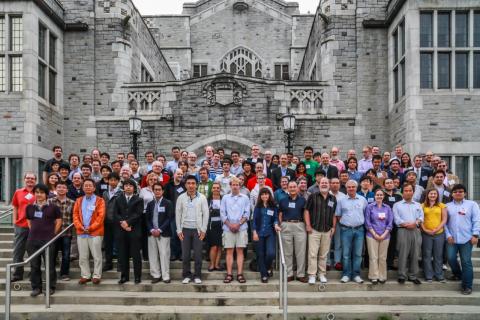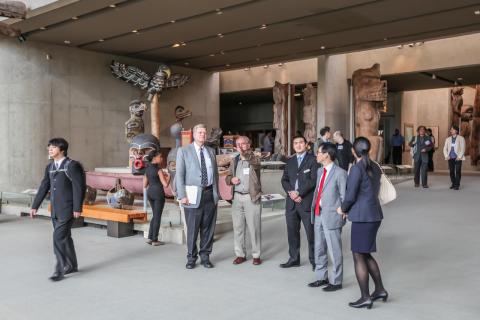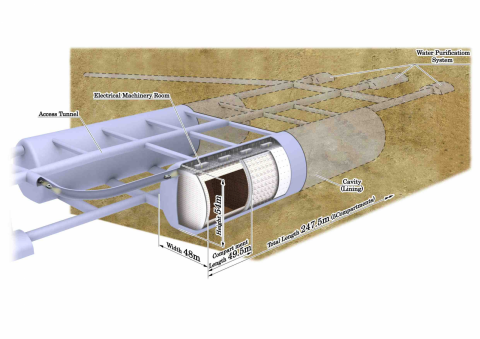


For the first time, the 5th Open Meeting for the Hyper-Kamiokande (Hyper-K) Project was held outside of Japan in Vancouver at TRIUMF and UBC from July 19-22. TRIUMF researchers Akira Konaka (TRIUMF), Sampa Bhadra (York), and Hirohisa Tanaka (UBC/IPP) hosted the conference, which was attended by nearly 100 scientists from across Canada, Japan, Italy, US, UK, Brazil and other partner countries. Several key international representatives attended the meeting and encouraged global collaboration for the Hyper-K project. This meeting intended to help define Hyper-K’s plans and strategies.
Sampa Bhadra, Professor at York University, said, “We carved a path forward scientifically, and were able to have frank and free discussions on various detector designs and technology, with global intellectual input. We also formed a consensus that we would formalize an international collaboration to push the project forward, while exploring all avenues to optimize the capabilities of the experiment.”
Based in Japan, the Hyper-K project is a proposed flagship experiment to advance research in neutrinos and proton decay by constructing an enormous detector containing 1 megatonne of water viewed by nearly 100 thousand photosensors. Hyper-K would detect neutrino interactions and proton decay by the Cherenkov light emitted in these processes, and would be more than 20 times larger than the current Super-Kamiokande detector. Supported by the Science Council of Japan and being reviewed by the Japanese Ministry of Education, Culture, Sports, Science and Technology (MEXT), Hyper-K builds on a strong history of Japanese-led international collaborations in particle physics, and is supported by a consortium of 67 institutes and 12 countries.
The role of TRIUMF as a host for the meeting was no arbitrary choice. Canada’s leadership in the Hyper-K proposal extends from its significant role in the T2K project – the ongoing international partnership in which Canadian collaborators have made key contributions and constitute a significant proportion of project participants. Converging around the expertise, knowledge and reputation of TRIUMF, the Hyper-K meeting provided Canada an opportunity to not only promote its scientific capabilities to an audience of world’s leading physicists, but also highlight Canada’s position as a premier partner in high-profile international scientific collaborations.
The Hyper-K project proposes to advance the training of highly qualified persons and facilitate the development of new technologies. An example of a commercial outcome can be found in Canada’s support of the T2K project, wherein the development of a multi-pixel photon counter has found new applications in areas such as medical physics, material science, and geotomography.
A reception held on July 20 at UBC’s Museum of Anthropology that contributed towards the cooperative occasion. TRIUMF Director Dr. Jonathan Bagger introduced delegates and invited guests to the meeting facilitated by Tsuyoshi Nakaya (Kyoto), Director of SNOLAB Nigel Smith, IPP Director Mike Roney, as well as Akira Konaka (TRIUMF), Sampa Bhadra (York), and Hirohisa Tanaka (UBC/IPP). The meeting drew international attention and welcomed Masashi Hattori, Embassy of Japan (Ottawa); Satomi Yoshino, Japan’s Consulate General Office, Vancouver; Sudha Kshatriya, Department of Foreign Affairs and Trade Development; as well as Professor Hiroaki Aihara, Vice President of Tokyo University. Invited guests, including the Japanese Consul General, toured the TRIUMF facility and were impressed with the laboratory.
The meeting was a great success and solidified the steps for a formal, international collaboration.
– Melissa Baluk, Communications Coordinator
PhotosTop: Participiants in the 5th Open Meeting for the Hyper-Kamiokande Project.Middle: Particpiants, including TRIUMF Director Dr. Jonathan Bagger, Japan’s Consulate General Office in Vancouver, and Department of Foreign Affairs and Trade Development, at the Museum of Anthropology reception. Bottom: Schematic of the proposed Hyper-K detector.
